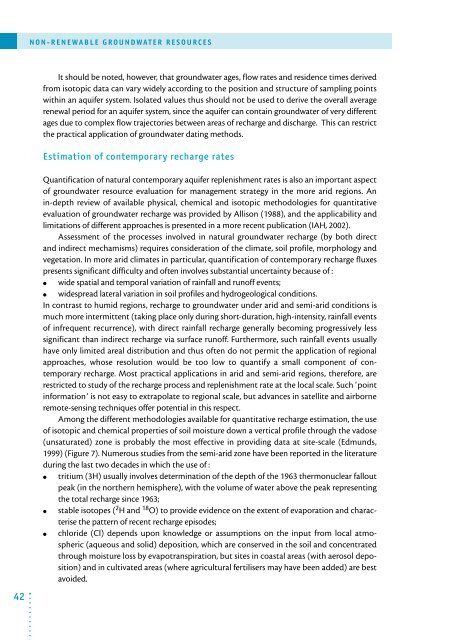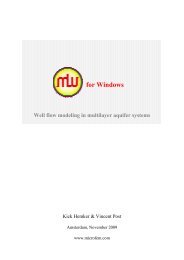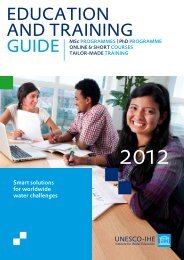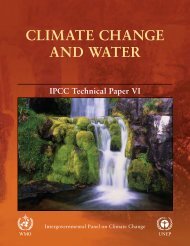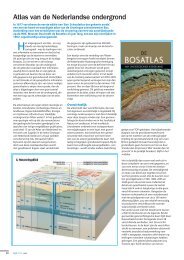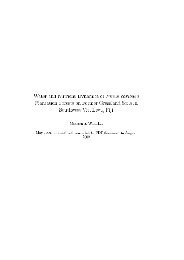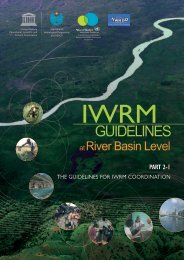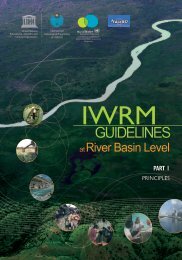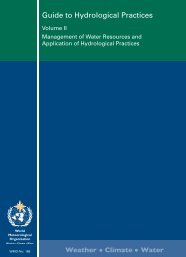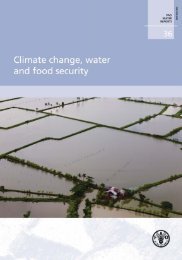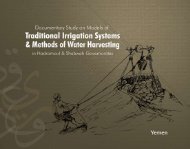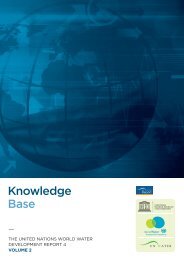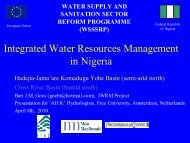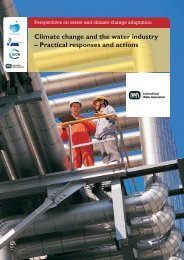Non-renewable groundwater resources: a ... - unesdoc - Unesco
Non-renewable groundwater resources: a ... - unesdoc - Unesco
Non-renewable groundwater resources: a ... - unesdoc - Unesco
- No tags were found...
Create successful ePaper yourself
Turn your PDF publications into a flip-book with our unique Google optimized e-Paper software.
NON-RENEWABLE GROUNDWATER RESOURCESIt should be noted, however, that <strong>groundwater</strong> ages, flow rates and residence times derivedfrom isotopic data can vary widely according to the position and structure of sampling pointswithin an aquifer system. Isolated values thus should not be used to derive the overall averagerenewal period for an aquifer system, since the aquifer can contain <strong>groundwater</strong> of very differentages due to complex flow trajectories between areas of recharge and discharge. This can restrictthe practical application of <strong>groundwater</strong> dating methods.Estimation of contemporary recharge rates42Quantification of natural contemporary aquifer replenishment rates is also an important aspectof <strong>groundwater</strong> resource evaluation for management strategy in the more arid regions. Anin-depth review of available physical, chemical and isotopic methodologies for quantitativeevaluation of <strong>groundwater</strong> recharge was provided by Allison (1988), and the applicability andlimitations of different approaches is presented in a more recent publication (IAH, 2002).Assessment of the processes involved in natural <strong>groundwater</strong> recharge (by both directand indirect mechamisms) requires consideration of the climate, soil profile, morphology andvegetation. In more arid climates in particular, quantification of contemporary recharge fluxespresents significant difficulty and often involves substantial uncertainty because of :● wide spatial and temporal variation of rainfall and runoff events;● widespread lateral variation in soil profiles and hydrogeological conditions.In contrast to humid regions, recharge to <strong>groundwater</strong> under arid and semi-arid conditions ismuch more intermittent (taking place only during short-duration, high-intensity, rainfall eventsof infrequent recurrence), with direct rainfall recharge generally becoming progressively lesssignificant than indirect recharge via surface runoff. Furthermore, such rainfall events usuallyhave only limited areal distribution and thus often do not permit the application of regionalapproaches, whose resolution would be too low to quantify a small component of contemporaryrecharge. Most practical applications in arid and semi-arid regions, therefore, arerestricted to study of the recharge process and replenishment rate at the local scale. Such ‘pointinformation‘ is not easy to extrapolate to regional scale, but advances in satellite and airborneremote-sensing techniques offer potential in this respect.Among the different methodologies available for quantitative recharge estimation, the useof isotopic and chemical properties of soil moisture down a vertical profile through the vadose(unsaturated) zone is probably the most effective in providing data at site-scale (Edmunds,1999) (Figure 7). Numerous studies from the semi-arid zone have been reported in the literatureduring the last two decades in which the use of :● tritium (3H) usually involves determination of the depth of the 1963 thermonuclear falloutpeak (in the northern hemisphere), with the volume of water above the peak representingthe total recharge since 1963;● stable isotopes ( 2 H and 18 O) to provide evidence on the extent of evaporation and characterisethe pattern of recent recharge episodes;● chloride (Cl) depends upon knowledge or assumptions on the input from local atmospheric(aqueous and solid) deposition, which are conserved in the soil and concentratedthrough moisture loss by evapotranspiration, but sites in coastal areas (with aerosol deposition)and in cultivated areas (where agricultural fertilisers may have been added) are bestavoided.


